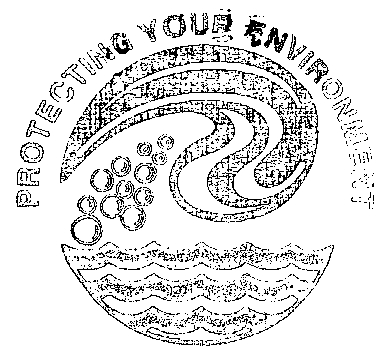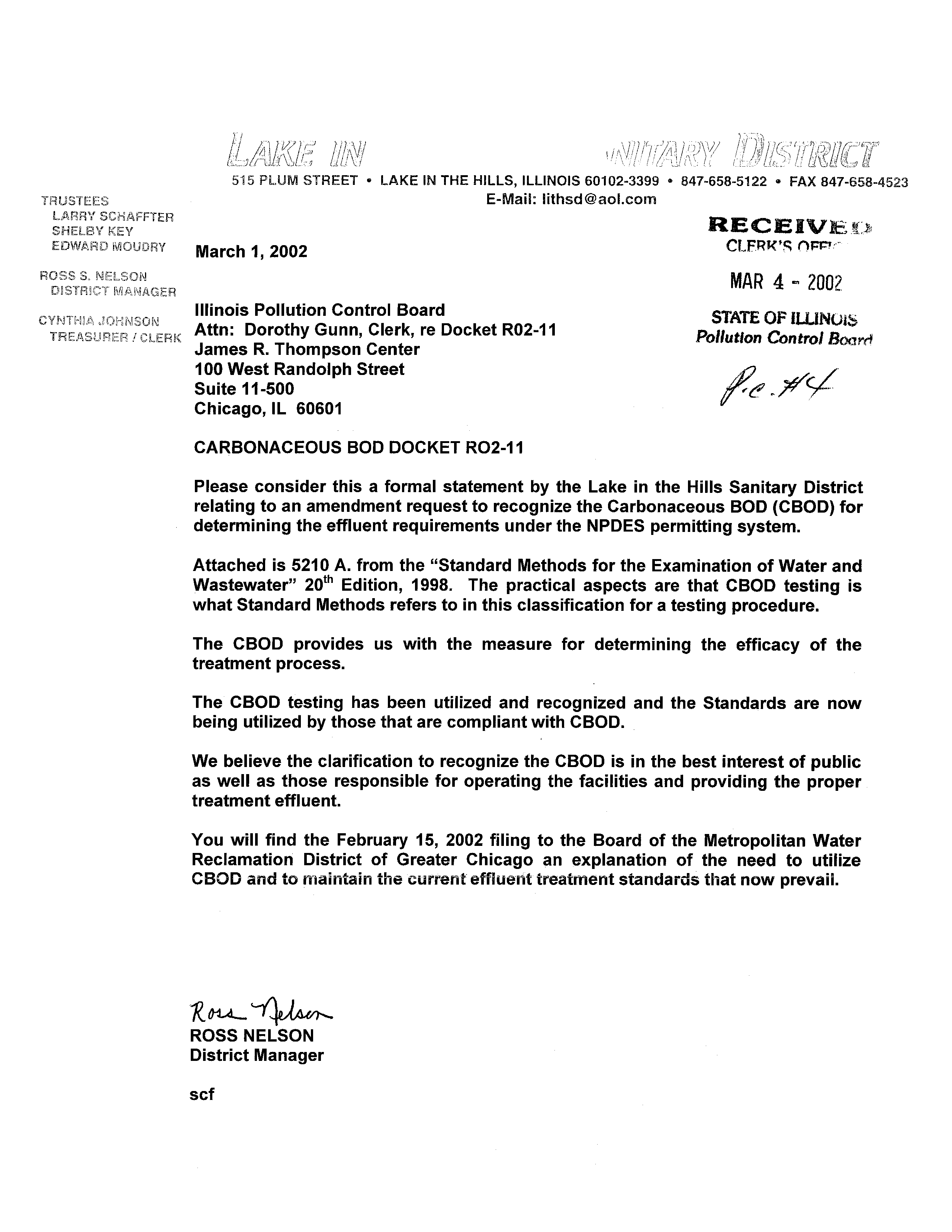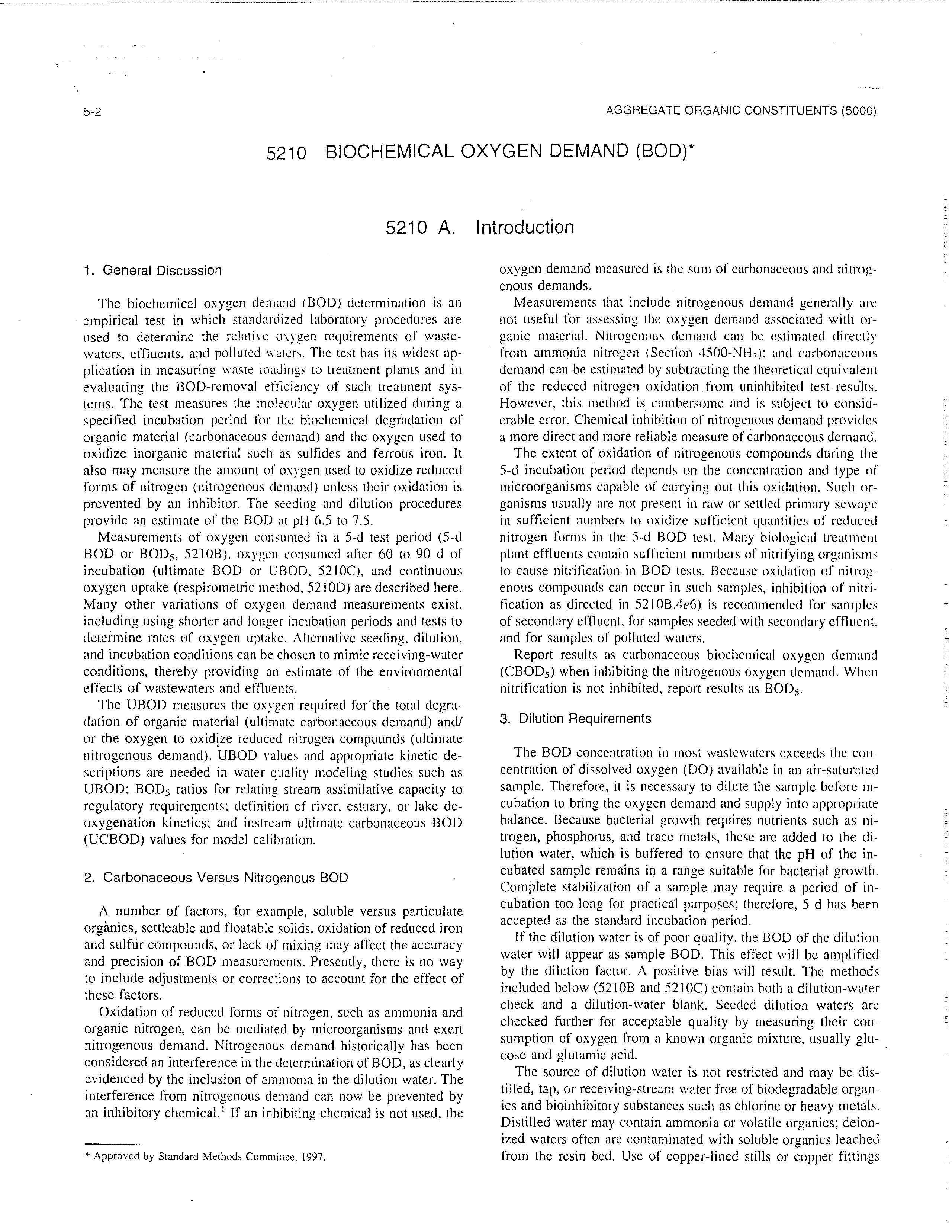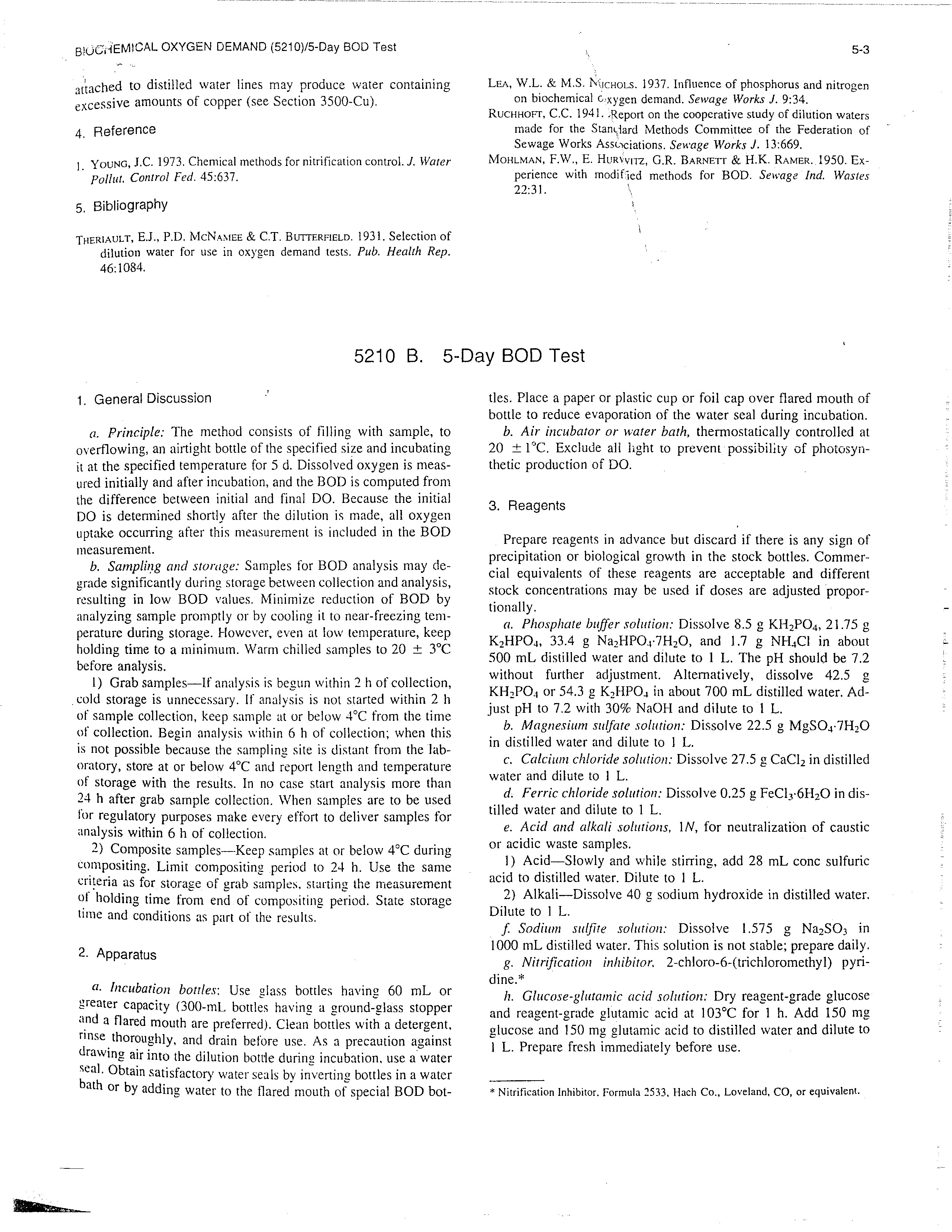~/~/z~/~//
~‘
~
515
PLUM STREET
• LAKE IN THE HILLS, ILLINOIS 60102-3399
E-Mail: Iithsd@aol.com
RECEIVE
~i
March 1, 2002
CLFRI~S flFp!’•
MAR 4
2002
Illinois Pollution Control Board
STATE OF IWN ~
Attn: Dorothy Gunn, Clerk, re Docket R02-1 I
Pollution Control
&cirr~
James R. Thompson Center
100 West Randolph Street
Suite 11-500
Chicago, IL
60601
CARBONACEOUS BOO DOCKET RO2-1 I
Please consider this a formal statement by the Lake in the Hills Sanitary District
relating to an amendment request to recognize the Carbonaceous BOD (CBOD) for
determining the effluent requirements under the NPDES permitting system.
Attached is 5210 A. from the “Standard Methods for the Examination of Water and
Wastewater”
20th
Edition, 1998. The practical aspects are that CBOD testing is
what Standard Methods refers to in this classification for a testing procedure.
The CBOD provides us with the measure for determining the efficacy of the
treatment process.
The CBOD testing has been utilized and recognized and the Standards are now
being utilized by those that are compliant with CBOD.
We believe the clarification to recognize the CBOD is in the best interest of public
as well as those responsible for operating the facilities and providing the proper
treatment effluent.
You will find the February 15, 2002 filing to the Board of the Metropolitan Water
Reclamation District of Greater Chicago an explanation of the need to utilize
CBOD and to maintain the current effluent treatment standards that now prevail.
ROSS NELSON
District Manager
TRUSTEES
LP~RRVSC~AFFTER
SHELEW L~EY
EDW~RL~MOUJRY
ROSS S NELSON
EWTR.~TF’f~~A(~ER
CYHTH’r O—~~~ON
TREASU~~:CLERK
If
!~‘~/./‘~~/
~.;y
~1;/~ ~
?~/
• 847-658-5122
• FAX 847-658-4523
scf
5-2
AGGREGATE ORGANIC CONSTITUENTS (5000)
5210 BIOCHEMICAL OXYGEN DEMAND (BOD)*
5210 A. Introduction
1. General Discussion
The biochemical oxygen demand
BOD)
determination is an
empirical test in which standardized laboratory procedures are
used to determine the relatis e
O\\
gen requirenients of waste-
waters, effluents, and polluted
\\
ater~.The test has its widest ap-
plication in measuring waste loadings to treatment plants and in
evaluating the BUD-removal efficiency of such treatment sys-
tems. The test measures the molecular oxygen utilized during a
specified incubation period for the biochemical degradation of
organic material (carbonaceous demand) and the oxygen used to
oxidize inorganic material such as sulfides and ferrous iron. It
also may measure the amount of ox)gen used to oxidize reduced
forms of nitrogen (nitrogenous demand) unless their oxidation is
prevented by an inhibitor. The seeding and dilution procedures
1xovide an estimate of the BOD at pH 6.~to 7.5.
Measurements of oxygen consumed in a
5-d
test period (5-d
BUD or BUD3, 5210B). oxygen consumed after 60 to 90 d of
incubation (ultimate BOD or UBOD, 5210C), and continuous
oxygen uptake (respirometric method. 5210D) are described here.
Many other variations of oxygen demand measurements exist,
including using shorter and longer incubation periods and tests to
determine rates of oxygen uptake. Alternative seeding. dilution,
and incubation conditions can be chosen to mimic receiving-water
conditions, thereby providing an estimate of the environmental
effects of wastewaters and effluents.
The UBOD measures the oxygen required forthe total degra-
dation of organic material (ultimate carbonaceous demand) and!
or the oxygen to oxidize reduced nitrogen compounds (ultiniate
nitrogenous demand). UBOD values and appropriate kinetic de-
scriptions are needed in water quality modeling studies such as
UBOD: BUD5 ratios for relating stream assimilative capacity to
regulatory requirerpents; definition of river, estuary, or lake de-
oxygenation kinetics; and instream ultimate carbonaceous BUD
(UCBOD) values for model calibration.
2. Carbonaceous
Versus Nitrogenous
BOD
A number of factors, for example, soluble versus particulate
orgànics, settleable and floatable solids, oxidation of reduced iron
and sulfur compounds, or lack of mixing may affect the accuracy
and precision of BUD measurements. Presently, there is no way
to include adjustments or corrections to account for the effect of
these factors.
Oxidation of reduced forms of nitrogen, such as ammonia and
organic nitrogen, can be mediated by microorganisms and exert
nitrogenous demand. Nitrogenous demand historically has been
considered an interference in the determination of BOD, as clearly
evidenced by the inclusion of ammonia in the dilution water. The
interference from nitrogenous demand can now be prevented by
an inhibitory chemical.’ If an inhibiting chemical is not used, the
Approved by Standard Methods Cornmf,,ee. 1997.
oxygen demand measured is the sum of carbonaceous and nitrog-
enous demands.
Measurements that include nitrogenous demand generally arc
not useful for assessing the oxygen demand associated with or-
ganic material. Nitrogenous demand can he estimniued directly
from ammonia nitrogen (Section 4500—NH-d: and carbonaceous
demand can be estimated by subtracting the theoretical equivalent
of the reduced nitrogen oxidation from uninhibited test results.
However, this method is cumbersome and is subject to consid-
erable error. Chemical inhibition of nitrogenous demand provides
a more direct and more reliable measure of carbonaceous demand.
The extent of oxidation of nitrogenous compounds during the
5-d incubation period depends on the concentration artd type of
microorganisms capable of carrying out this oxidation. Such or-
ganisms usually are not present in raw or settled primary sewage
in sufficient numbers to oxidize sufficient quantities of reduced
nitrogen forms in the 5—d B OD test. Many biological treat ment
plant effluents contain sufficient numbers of nitrifying organisms
to cause nitrification in BOD tests. Because oxidatioti of nitros~—
enous compounds can occur in such samples. inhibition of nitri—
fication as directed in 521 OB.4e6) is recommended for samples
of secondary effluent, for samples seeded with secondary effluent,
and for samples of polluted waters.
Report results as carbonaceous biochemical oxygen demand
(CBOD5) when inhibiting the nitrogenous oxygen demand. When
nitrification is not inhibited, report results as BUD5.
3. Dilution Requirements
The BUD concentration in most wastewa(ers exceeds the con-
centration of dissolved oxygen (DO) available in an air-saturated
sample. Therefore, it is necessary to dilute the sample before in-
cubation to bring the oxygen demand and supply into appropriate
balance. Because bacterial growth requires nutrients such as ni-
trogen, phosphorus, and trace metals, these are added to the di-
lution water, which is buffered to ensure that the pH of the in-
cubated sample remains in a range suitable for bacterial growth.
Complete stabilization of a sample may require a period of in-
cubation too long for practical purposes; therefore, 5 d has been
accepted as the standard incubation period.
If the dilution \vater is of poor quality, the BOD of the dilution
‘water will appear as sample BUD. This effect will be amplified
by the dilution factor. A positive bias will result. The methods
included below (5210B and 5210C) contain both a dilution-water
check and a dilution-water blank. Seeded dilution waters are
checked further for acceptable quality by measuring their con-
sumption of oxygen from a known organic mixture, usually glu-
cose and glutamic acid.
The source of dilution water is not restricted and may be dis-
tilled, tap, or receiving-stream water free of biodegradable organ-
ics and bioinhibitory substances such as chlorine or heavy metals.
Distilled water may contain ammonia or volatile organics; deion-
ized waters often are contaminated with soluble organics leached
from the resin bed. Use of copper-lined stills or copper fittings
BtoC~EMt~~~M..OXYGEN DEMAND (5210)/5-Day BOO Test
5-3
ar~achedto distilled water lines may produce water containing
excessive amounts of copper (see Section 3500-Cu).
4.
Reference
I. YOUNG, J.C. 1973. Chemical methods for nitrification control.
J.
Water
Pal/ut. Control Fed.
45:637.
5. Bibliography
THERIAULT, E.J., P.D. MCNA\IEE & CT. BU1-rERF1ELr,. (931. Selection of
dilution water for use in oxygen demand tests.
Pub. Health Rep.
46:1084.
LEA, W.L. & MS. i’~IcHoLs.1937. Influence of phosphorus and nitrogen
on biochemical £ xygen demand.
Sewage Works J.
9:34.
RUCHHOFT, CC. 1941. .Report on the cooperative study of dilution waters
made for the Stansiard Methods Committee of the Federation of
Sewage Works Assc~ciations.
Sewage Works J.
13:669.
MOHLMAN, F.W., E. HURSVrrz, OR. BARNETr & H.K. RAMER. 1950. Ex-
perience with modified methods for BOD.
Sewage md. Wastes
22:31.
5210 B. 5-Day BOD Test
i. General Discussion
-,
a.
Principle:
The method consists of filling with sample, to
overflowing, an airtight bottle of the specified size and incubating
it at the specified temperature for 5 d. Dissolved oxygen is meas-
ured initially and after incubation, and the BUD is computed from
the difference between initial and final DO. Because the initial
DO is determined shortly after the dilution is made, all oxygen
uptake occurring after this measurement is included in the BUD
nieasurement.
b. Sampling and storage:
Samples for BOD analysis may de-
grade significantly during storage between collection and analysis,
resulting in low BUD values. Minimize reduction of BUD by
analyzing sample promptly or by cooling it to near-freezing tcni-
perature during storage. However, even at low temperattire, keep
holding time to a minimum. Warm chilled samples to 20 ±3°C
before analysis.
1) Grab samples—If analysis is begun within 2 h of collection,
cold storage is unnecessary. If analysis is not started within 2 Ii
of sample collection, keep sample at or below 4°Cfrom the time
of collection. Begin analysis within 6 h of collection; when this
is not possible because the sampling site is distant from the lab-
oratory, store at or below 4°Cand report length and temperature
of storage with the results. In no case start analysis more than
24 h after grab sample collection. \Vhen samples are to be used
br regulatory purposes make every effort to deliver samples for
analysis within 6 h of collection.
2) Composite samples—Keep samples at or below 4°Cduring
compositing. Limit compositing period to 24 h. Use the same
criteria as for storage of grab samples. starting the measurement
of holding time from end of compositing period. State storage
time and conditions as part of the results.
2.
Apparatus
a. incubation botr/e.c:
Use glass bottles having 60 mL or
greater capacity (300-mL bottles having a ground-glass stopper
and a flared mouth are preferred). Clean bottles with a detergent.
rinse thoroughly, anti drain before use. As a precaution against
drawing air into the dilution bottle during incubation, use a water
scal. Obtain satisfactory water seals by inverting bottles in a water
bath or by adding water to the flared mouth of special BUD bot-
tles. Place a paper or plastic cup or foil cap over flared mouth of
bottle to reduce evaporation of the water seal during incubation.
b. Air incubator or water bath,
thermostatically controlled at
20 ±1°C. Exclude all light to prevent possibility of photosyn-
thetic production of DO.
3. Reagents
Prepare reagents in advance but discard if there is any sign of
precipitation or biological growth in the stock bottles. Commer-
cial equivalents of these reagents are acceptable and different
stock concentrations may be used if doses are adjusted propor-
tionally.
a. Phosphate buffer solution:
Dissolve 8.5 g KH2PO4, 21.75 g
K2HPO4, 33.4 g Na2HPO47H2O, and 1.7 g NH4CI in about
500 mL distilled water and dilute to 1 L. The pH should be 7.2
without further adjustment. Alternatively, dissolve 42.5 g
Kl-12PO4 or 54.3 g K2HPO4 in about 700 mL distilled water. Ad-
just pH to 7.2 with 30 NaOH and dilute to I L.
b. Magnesium sulfate solution:
Dissolve 22.5 g MgSO47H20
in distilled water and dilute to I L.
c. Calcium chloride solution:
Dissolve 27.5 g CaCl2 in distilled
water and dilute to 1 L.
d. Ferric chloride solution:
Dissolve 0.25 g FeCIy6H2O in dis-
tilled water and dilute to 1 L.
e. Acid and alkali solutions,
1N, for neutralization of caustic
or acidic waste samples.
I) Acid—Slowly and while stirring, add 28 mL cone sulfuric
acid to distilled water. Dilute to I L.
2) Alkali—Dissolve 40 g sodium hydroxide in distilled water.
Dilute to I L.
f
Sodium sulfite solution:
Dissolve 1.575 g Na2SO3 in
1000 mL distilled water. This solution is not stable; prepare daily.
g. Nitrtficatiotu inhibitor,
2-chloro-6-(trichloromethyl) pyri-
dine.*
It. Glucose-glutatnic acid solution:
Dry reagent-grade glucose
and reagent-grade glutaniic acid at 103°Cfor I h. Add 150 mg
glucose and 150 mg glutamic acid to distilled water and dilute to
1 L. Prepare fresh immediately before use.
*
Nitrification Inhibitor. Formula 2533, Hach Co., Loveland, CO, or equivalent.





